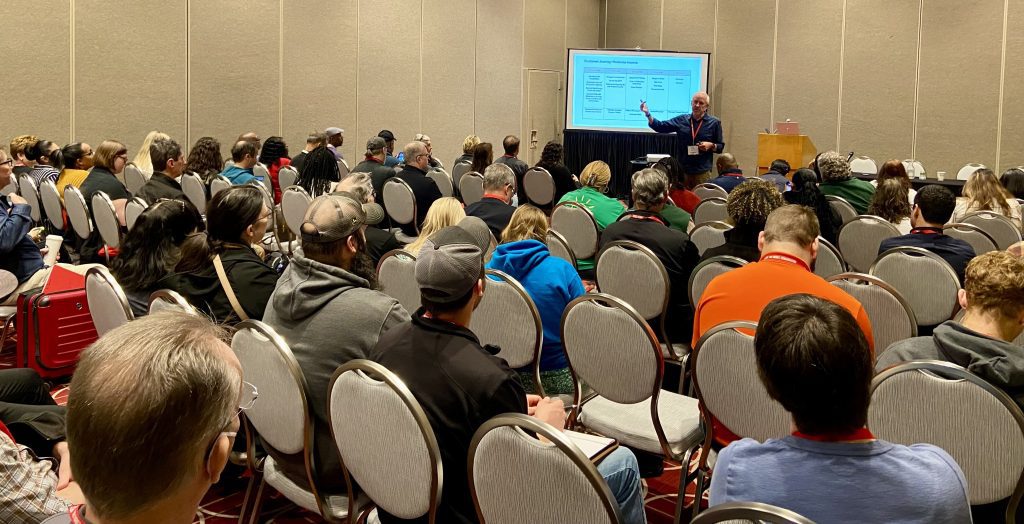May 1, 2024
Marketing to Low- and Moderate-Income Communities
You need to know the answer to four questions to properly market to low- and moderate-income households.
By: Macie Melendez
A couple of weeks ago at our National Home Performance Conference & Trade Show, I attended Peter Troast’s session, Marketing to Low and Moderate Income (LMI) Households Online. Troast is the CEO and Founder of Energy Circle—a home performance-focused digital marketing agency located in Maine.
This session focused on why more attention should be paid to LMI audiences—an important audience for our industry always, but even more so as the Inflation Reduction Act (IRA) rebate programs make work in LMI homes a priority.
Troast began his session by stating that marketing and low to moderate income households are phrases that we don’t often see together. He said that we have the wrong assumption in our industry that people in that category have other ways of hearing about our services.

In fact, the truth is that most homes in the United States are owned or rented by people of LMI status. And they don’t know the rebates or incentives available to them. But that’s not just true for the IRA rebates. During the session, one attendee said that her state’s rebate programs have been around for 12 years and people still don’t know about it.
It’s also true that a lot of home performance and weatherization teams don’t have dedicated marketing teams. So, how can we fix that? What do you need to know in order to market your business to this group of people?
If you ask Troast, you need to know the answer to four questions:
- Who are you talking to?
- What are they motivated by?
- What are they interested in?
- Why do they want to enter the energy efficiency world?
When answering these questions, you’ll quickly see that different homeowners have different motivation and interests. So, you’ll need to adjust your marketing accordingly.
For example, a young couple without kids or a young family will have similar motivations. They want to fix their home and raise value, but they likely plan to move—usually to a better or bigger place in the future. In other words, they live in their starter home, which is serving as a steppingstone to a forever home.
However, if you look at a retired couple, for example, they’ll have a different motivation. They are in their forever home that they want to live in comfortably with as little maintenance as possible.
Of course, there are general commonalities that you can draw from. Troast said that homeowners will generally reach out to our industry for one of the following reasons:
- They want to reduce energy costs
- They want to fix comfort problems
- They want to add home value
- They want to get rebates
- They want to help the climate or environment
While our industry has been conditioned to talk about comfort, it’s important to know that, in the past few years, energy costs have gone through the roof. As Troast pointed out, energy poverty is a real problem. According to The White House, “one of the largest costs for many Americans is heating, cooling, and powering their homes—with the lowest-income families spending upwards of 30% of their income on energy bills.”

So, here’s Troast’s recommendations on what you, as a home performance business or contractor, can do to properly market yourself and help people reduce this burden.
Start with income targeting by zip code. Using incomebyzipcode.com is a simple way to see who lives where. A portion of the IRA rebates are set aside for LMI communities, so this is a great way to determine where those people live so that you can reach them.
Give them a sense of urgency. Money from IRA rebates will go fast—and you can use that sense of urgency in your marketing. Get it before it’s gone!
Teach them things they don’t know. The 25C tax credit, for example, is available now and its price increased in the IRA. It can also be used several years in a row. Share that knowledge with them so that you can become a trusted resource in your community.
Think about your customer journey. How does your customer get to your website? When they get there, what do they find? Troast says to lead with the products first, then include the programs that help people finance those products. Consider including information on your local incentives. Include FAQs on your landing page.
Simplify. It’s no secret that people are confused. A lot of people have heard of electrification and call their electrician to get help. Unfortunately, electricians will sell them panel upgrades and not electric appliances or heat pumps. Use keywords on your website so that if they search for “electrification” on Google, they’ll end up learning about your services instead.
If you attended the conference and have a login, you can access Troast’s session slides here (listed under Breakout 10).
If not, Troast and his team are always putting out helpful marketing content on their blog.






